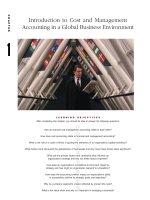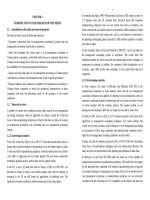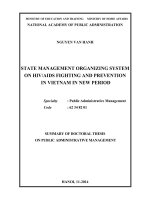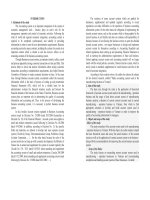Transformational leadership style, reward systems, management accounting system information and managerial performance
Bạn đang xem bản rút gọn của tài liệu. Xem và tải ngay bản đầy đủ của tài liệu tại đây (2.13 MB, 320 trang )
Griffith Business School
Submitted in fulfilment of the requirements of the degree of
Doctor of Philosophy
by
Thi Thu Nguyen
June 2014
Transformational Leadership Style, Reward Systems,
Management Accounting System Information and
Managerial Performance: The Impact of Ownership Type in
Vietnamese Enterprises
Thi Thu Nguyen
M.B.A, M.Acc.
Department of Accounting, Finance and Economics
Griffith Business School
Griffith University
Submitted in fulfilment of the requirements of the degree of
Doctor of Philosophy
June 2014
Abstract
In a competitive business environment, managers’ need for broad scope management
accounting system (MAS) information for decision making increases. This information
is critical for facilitating managers to gain a better understanding of a competitive
environment and to respond to uncertain situations. Such understanding, in turn, helps
managers to make more effective decisions, thereby improving their performance.
The extant literature suggests that several factors, such as organisational structure and
external environment, may have an impact on managers’ use of broad scope MAS
information (hereafter, the MAS information) and on their performance. However, the
literature suggests that such an impact varies depending on contexts such as countries
and cultures. In a transitional economy, as in Vietnam, studies investigating the impact of
these factors on managers’ use of the MAS information and on their performance are
rather scarce. Vietnam is in the process of transforming from a centrally planned
economy to a market-oriented one characterised by a competitive business environment,
organisations with multiple ownership types and a mix of leadership styles and reward
systems. The relevant literature argues that the impact of different ownership types,
leadership styles and reward systems in the transitional economy of Vietnam may differ
from that found in a western country’s developed economy. However, an extensive
literature review suggests that research on the impact of leadership style, reward system,
and ownership type on managers’ use of the MAS information and their performance in
Vietnam has yet to be conducted. The current study addresses this shortcoming.
This study sets out to determine several direct, mediation and moderation effects:
i
(a) the direct relationships between transformational leadership style (TLS), reward
systems (RS), managers’ use of the MAS information, and managerial
performance (MP);
(b) the indirect relationships (i) between TLS and MP via managers’ use of the
MAS information, (ii) between RS and MP via managers’ use of the MAS
information, (iii) between TLS and MP via RS, and (iv) between TLS and
managers’ use of the MAS information via RS; and
(c) the moderating impact of ownership types on these relationships in Vietnamese
enterprises (divided into three groups: state-owned (including enterprises with
the state as the majority shareholder); privately owned (100% domestic private);
and foreign-owned (including partial and 100% foreign investment) enterprises
(hereafter abbreviated as SOEs, POEs and FOEs, respectively).
A questionnaire survey and in-depth face-to-face interviews were conducted to collect
data. One hundred and ninety-one department managers in Vietnamese enterprises with
different ownership types participated in the study. Data collected from the survey were
used to run partial least square (PLS) path models to test the hypotheses for the above
effects. Information from the interviews was used to enrich understanding of the
hypothesised relationships and to explain the impact of ownership types on these
relationships.
The results of this study reveal that:
all direct relationships in (a) were positive and significant;
ii
all indirect relationships in (b) were significant, with one exception that the RS
had no mediating role in the relationship between TLS and MP; and
ownership type had an impact on the direct relationships: (i) between RS and
managers’ use of the MAS information and between TLS and MP because these
relationships were positive and significant in POEs and FOEs, but not
significant in SOEs; (ii) between RS and MP because this relationship was
positive and significant in POEs, but not significant in the others; and (iii)
between managers’ use of the MAS information and MP because this
relationship in FOEs was significantly lower than it was in the others;
ownership type had a moderating effect on the indirect relationships: (i) between
TLS and MP via managers’ use of the MAS information as this indirect effect
was significant in SOEs and POEs, but not significant in FOEs; (ii) between
TLS and MP via RS since this indirect effect was significant in POEs, but not
significant in the others; and (iii) between TLS and managers’ use of the MAS
information via RS because this indirect effect was significant in POEs and
FOEs, but not significant in SOEs.
The study found no support for the impact of ownership type on: (i) the direct
relationship between TLS and managers’ use of the MAS information and between TLS
and RS; and (ii) the indirect relationship between RS and MP via managers’ use of the
MAS information. These relationships were all positive and significant in each of the
three groups of enterprises.
iii
iv
Statement of Originality
This work has not previously been submitted for a degree or diploma in any university.
To the best of my knowledge and belief, the thesis contains no material previously
published or written by another person except where due reference is made in the thesis
itself.
_____________________
Thi Thu Nguyen
v
vi
List of Publications Derived from this Study
1. Nguyen, T. T., Mia, L., & Huang, A. (2013). Reward systems, MAS
information and managerial performance: The impact of ownership type. Paper
presented at the 7th Asia Pacific Interdisciplinary Research in Accounting
Conference, Kobe, Japan.
2. Nguyen, T. T., Mia, L., & Winata, L. (2013). Transformational leadership style,
MAS information and managerial performance: The impact of ownership type.
Paper presented at two conferences: (1) The 49th British Accounting & Finance
Association Annual Conference, Newcastle, UK; and (2) The 2013 Environment
and
Sustainability
Management
Conference at Gold Coast, Australia.
vii
Accounting
Network
(EMAN)
Global
viii
Acknowledgement
I would like to express my heartfelt appreciation to my supervisors, Professor Lokman
Mia and Dr. Lanita Winata, for their constructive guidance, support, and encouragement
throughout my PhD candidature at Griffith University.
My gratitude also goes to The Ministry of Education and Training of Vietnam (MOET)
and Griffith University for providing me with a MOET scholarship. Many thanks are
also due to the Department of Accounting and Auditing, University of Economics of Ho
Chi Minh City for granting me time to undertake this research.
I wish to thank many colleagues and friends, Professor Tom Nguyen, Associate
Professor Reza Monem, Associate Professor John Sands, Dr. Allan Huang, Sharron
Vercoe, Susan MacLeod, Jennifer Beale, Dr. Ngoc Phi Anh Doan, Utami Puji Lestari,
Riana Sitawati, and friends in Vietnamese PhD group at Griffith University, for their
assistance, suggestions, and on-going encouragement.
My sincere thanks go to colleagues at Griffith University, University of Economics of
Ho Chi Minh City, and M.A.P Advertising – Printing company for participating in the
pilot study. Their suggestions on the draft questionnaire package contributed
significantly to the success of the survey. My appreciation also goes to department
managers in Vietnamese enterprises for taking part in this research.
Finally, I would like to thank my beloved family members. Without their love, care,
support, and encouragement, I could not overcome many difficulties and complete this
PhD thesis.
ix
x
Table of Contents
Abstract ................................................................................................................................. i
Statement of Originality...................................................................................................... v
List of Publications Derived from this Study .................................................................. vii
Acknowledgement ............................................................................................................... ix
Table of Contents ................................................................................................................. 1
List of Abbreviations ........................................................................................................... 6
List of Figures ...................................................................................................................... 8
List of Tables ........................................................................................................................ 9
Chapter 1: Introduction .................................................................................................... 11
1.1 Research Background .............................................................................................. 11
1.2 Research Motivations .............................................................................................. 15
1.2.1 The need to examine managers’ use of the MAS information in Vietnam .... 15
1.2.2 The need to examine the influence of related factors on managers’ use of
the MAS information in Vietnam ............................................................................ 15
1.2.3 The need to examine the effects of leadership style and reward systems on
managers’ use of the MAS information .................................................................. 18
1.2.4 The need to examine the impact of ownership type on the relationship
between leadership style, reward systems and managers’ use of the MAS
information .............................................................................................................. 19
1.3 Research Objectives and Scope of the Research ..................................................... 20
1.4 Research Model ....................................................................................................... 22
1.5 Research Method ..................................................................................................... 25
1.6 Research Setting: Vietnam ...................................................................................... 26
1.7 Structure of the Thesis ............................................................................................. 28
Chapter 2: Literature Review .......................................................................................... 31
1
2.1 Contingency Theory ................................................................................................ 32
2.2 Contingency-based Studies on Managers’ Use of the MAS Information ............... 35
2.3 Reward Systems ...................................................................................................... 46
2.4 Leadership Style ...................................................................................................... 50
2.5 Managerial Performance.......................................................................................... 59
2.5.1 Managers’ use of the MAS information and managerial performance .......... 63
2.5.2 Reward systems and managerial performance ............................................... 65
2.5.3 Transformational leadership style and managerial performance .................... 67
2.6 Ownership Type ...................................................................................................... 68
Chapter Summary .......................................................................................................... 71
Chapter 3: Hypothesis Development ............................................................................... 75
Introduction ................................................................................................................... 75
3.1 Direct Relationships ................................................................................................ 76
3.1.1 Transformational leadership style and managers’ use of the MAS
information .............................................................................................................. 76
3.1.2 Transformational leadership style and reward systems .................................. 78
3.1.3 Reward systems and managers’ use of the MAS information........................ 80
3.1.4 Transformational leadership style and managerial performance .................... 82
3.1.5 Reward systems and managerial performance ............................................... 84
3.1.6 Managers’ use of the MAS information and managerial performance .......... 86
3.2 Mediating Effects .................................................................................................... 88
3.2.1 The mediating role of managers’ use of the MAS information in the
relationship between transformational leadership style and managerial
performance ............................................................................................................. 90
3.2.2 The mediating role of managers’ use of the MAS information in the
relationship between reward systems and managerial performance ....................... 92
3.2.3 The mediating role of reward systems in the relationship between
transformational leadership style and managerial performance .............................. 93
2
3.2.4 The mediating role of reward systems in the relationship between
transformational leadership style and managers’ use of the MAS information ...... 94
3.3 Moderating Effects .................................................................................................. 95
3.3.1 Impact of ownership type on the relationship between transformational
leadership style and managers’ use of the MAS information .................................. 97
3.3.2 Impact of ownership type on the relationship between transformational
leadership style and reward system ......................................................................... 99
3.3.3 Impact of ownership type on the relationship between reward systems and
managers’ use of the MAS information ................................................................ 100
3.3.4 Impact of ownership type on the relationship between transformational
leadership style and managerial performance ....................................................... 102
3.3.5 Impact of ownership type on the relationship between reward systems and
managerial performance ........................................................................................ 103
3.3.6 Impact of ownership type on the relationship between managers’ use of the
MAS information and managerial performance .................................................... 105
Chapter Summary ........................................................................................................ 106
Chapter 4: Research Methods ........................................................................................ 107
Introduction ................................................................................................................. 107
4.1 Research Method ................................................................................................... 107
4.1.1 Population and sample selection .................................................................. 111
4.1.2 Participants ................................................................................................... 112
4.1.3 Questionnaire preparation ............................................................................ 112
4.1.4 Pilot study ..................................................................................................... 113
4.1.5 Data collection .............................................................................................. 115
4.2 Preliminary Data Analysis ..................................................................................... 121
4.2.1 Data characteristics ....................................................................................... 121
4.2.2 Model characteristics .................................................................................... 135
Chapter Summary ........................................................................................................ 140
Chapter 5: Results ........................................................................................................... 141
3
Introduction ................................................................................................................. 141
5.1 Measurement Model .............................................................................................. 142
5.2 Structural Model .................................................................................................... 149
5.2.1 Common method bias test ............................................................................ 149
5.2.2 Collinearity ................................................................................................... 156
5.2.3 Path coefficients ........................................................................................... 157
5.2.4 Predictive relevance (Q2) .............................................................................. 160
5.2.5 Coefficient of determination (R2) ................................................................. 160
5.2.6 Effect size ..................................................................................................... 161
5.2.7 Heterogeneity................................................................................................ 164
5.3 Hypothesis Testing ................................................................................................ 175
5.3.1 Direct effects................................................................................................. 175
5.3.2 Mediating effect ............................................................................................ 178
5.3.3 Impact of ownership type (moderating effects) ............................................ 184
Chapter 6: Discussion and Conclusion .......................................................................... 213
Introduction ................................................................................................................. 213
6.1 Discussion of Findings .......................................................................................... 213
6.1.1 Direct effects................................................................................................. 213
6.1.2 Mediating effects .......................................................................................... 225
6.1.3 Moderating effects ........................................................................................ 231
6.2 Contributions of the Study..................................................................................... 246
6.2.1 Theoretical Implications ............................................................................... 246
6.2.2 Managerial Implications ............................................................................... 248
6.3 Limitations and Directions for Future Research.................................................... 251
6.4 Conclusion ............................................................................................................. 253
4
Appendices ....................................................................................................................... 261
Appendix A: Ethical Clearance Approval ................................................................... 261
Appendix B1: Letter .............................................................................................. 262
Appendix B2: Questionnaire ................................................................................. 263
Appendix C: Consent Form ......................................................................................... 269
Appendix D: Interview Information ............................................................................ 270
Appendix E: The Results of Moderator Analysis ........................................................ 273
Appendix E1: Moderating effect of foreign investment ........................................ 273
Appendix E2: Moderating effect of state investment ............................................ 274
Appendix E3: Moderating effect of firm age ........................................................ 275
Appendix E4: Moderating effect of total assets .................................................... 276
Appendix E5: Moderating effect of number of employees ................................... 277
Appendix E6: Summary of the results of moderating effects ............................... 278
Appendix F: Collinearity Assessment (Linear regression based on Lvs from PLSSEM path model) ......................................................................................................... 279
5
List of Abbreviations
ASEAN
Association of Southeast Asia Nations
AFTA
ASEAN Free Trade Agreement
APEC
Asia-Pacific Economic Cooperation
AVE
Average variance extracted
BP
Budget participation
BU
Business unit
CEO
Chief executive officer
CFA
Confirmatory factor analysis
CM
Communality
CR
Composite reliability
DEC
Decentralisation
DV
Dependent variable
EFA
Exploratory factor analysis
FDI
Foreign direct investment
FIs
Financial institutions
FOEs
Foreign-owned enterprises
GSO
General Statistics Office
HRM
Human resource management
IV
Independent variable
JIT
Just-in-time
JV
Joint venture
LBDQ
Leader Behavior Description Questionnaire
Lvs
Latent variable scores
MAPs
Management accounting practices
MA
Management accounting
MAS
Management accounting system
MIS
Management information system
MGA
Multi-group analysis
MLQ
Multi-factor Leadership Questionnaire
MP
Managerial performance
MV
Mediator variable
PEU
Perceived environmental uncertainty
6
POEs
Privately owned enterprises
PLS
Partial Least Square
RQ
Research questions
RS
Reward system
SBU
Strategic business unit
SEM
Structural equation modelling
SOEs
State-owned enterprises
TLS
Transformational leadership
TMTs
Top management teams
TU
Task uncertainty
UP
Use participation
VAF
Variance Accounted For
WTO
World Trade Organization
7
List of Figures
Figure 1.1. Theoretical Model ............................................................................................. 23
Figure 2.1. Framework for the Literature Review ............................................................... 31
Figure 3.1. Mediating Effect ............................................................................................... 89
Figure 4.1. Research Design .............................................................................................. 108
Figure 4.2. Sampling Process ............................................................................................ 118
Figure 4.3. Model Characteristics...................................................................................... 137
Figure 5.1. Measurement Model and Structural Model..................................................... 142
Figure 5.2. Common Method Bias Test in the PLS Model ............................................... 155
Figure 5.3. The Structural (Inner) Model .......................................................................... 159
Figure 5.4. Excluding the Exogenous Variables from the Structural Model .................... 163
Figure 5.5. Mediator Analysis Procedure in PLS-SEM .................................................... 179
Figure 5.6. Mediating Effect Models ................................................................................ 182
Figure 5.7. Mean Values of Latent Variables by Ownership ............................................ 187
Figure 5.8. PLS Path Model for SOEs .............................................................................. 190
Figure 5.9. PLS Path Model for POEs .............................................................................. 195
Figure 5.10. PLS Path Model for FOEs ............................................................................ 201
Figure 5.11. Submodels by Ownership Type .................................................................... 206
Figure 5.12. Path Coefficients by Ownership Type .......................................................... 208
8
List of Tables
Table 2.1. Summary of Studies Relating to MAS ............................................................... 37
Table 2.2. Characteristics of Leadership Styles .................................................................. 52
Table 2.3. Re-examining the Components of Leadership Styles ........................................ 53
Table 4.0. Non-response bias test ...................................................................................... 117
Table 4.1. Interviewee Demographics ............................................................................... 120
Table 4.2. Sample Demographics ...................................................................................... 124
Table 4.3. Descriptive Statistics ........................................................................................ 126
Table 4.4. Correlation Matrix ............................................................................................ 129
Table 4.5. Pattern Matrixa .................................................................................................. 130
Table 4.6. Transformational Leadership Style ─ Reliability and Correlation Matrix ....... 132
Table 4.7. Reward System ─ Reliability and Correlation Matrix ..................................... 133
Table 4.8. Use of the MAS Information ─ Reliability and Correlation Matrix ................ 133
Table 4.9. Managerial Performance ─ Reliability and Correlation Matrix ....................... 135
Table 4.10. Data Matrix for PLS-SEM Algorithm ............................................................ 136
Table 5.1. Rule of Thumb for Evaluating Reflective Measurement Model ...................... 143
Table 5.2. Reliability and Validity .................................................................................... 144
Table 5.3. Indicator Loadings ............................................................................................ 146
Table 5.4. Cross Loadings ................................................................................................. 148
Table 5.5. Harman’s Single-factor Test............................................................................. 151
Table 5.6. Common Method Bias Analysis ....................................................................... 154
Table 5.7. Path Coefficients' Significances Testing .......................................................... 159
Table 5.8 Effect Size of the Endogenous Construct .......................................................... 163
Table 5.9. PLS-MGA Results by Region .......................................................................... 166
9
Table 5.10. PLS-MGA Results by Age ............................................................................. 167
Table 5.11. PLS-MGA Results by Experience .................................................................. 168
Table 5.12. PLS-MGA Results by Firm Size .................................................................... 169
Table 5.13. PLS-MGA Results by Gender ........................................................................ 170
Table 5.14. PLS-MGA Results by Industry ...................................................................... 171
Table 5.15. PLS-MGA Results by Education.................................................................... 172
Table 5.16. PLS-MGA Results by Department ................................................................. 173
Table 5.17. Summary of the Results of the Structural Model (Inner Model).................... 177
Table 5.18. Summary of the Results of Mediating Effects ............................................... 183
Table 5.19. Frequency of Respondents Rating on 7-point Likert Scale (%) ..................... 185
Table 5.20. Descriptive Statistics ...................................................................................... 186
Table 5.21. Effect Size of the Endogenous Construct for SOEs ....................................... 191
Table 5.22. Summary of the Results of the Structural Model (Inner Model) for SOEs .... 192
Table 5.23. Summary of the Results of Mediating Effects for SOEs ................................ 192
Table 5.24. Effect Size of the Endogenous Construct for POEs ....................................... 196
Table 5.25. Summary of the Results of the Structural Model (Inner Model) for POEs .... 197
Table 5.26. Summary of the Results of Mediating Effects for POEs ................................ 198
Table 5.27. Effect Size of the Endogenous Construct for FOEs ....................................... 202
Table 5.28. Summary of the Results of the Structural Model (Inner Model) for FOEs .... 203
Table 5.29. Summary of the Results of Mediating Effects for FOEs ................................ 204
Table 5.30. PLS-MGA Results by Ownership Type ......................................................... 207
Table 5.31. Criteria for PSL Path Models by Ownership .................................................. 209
Table 5.32. Summary of Hypothesis Testing .................................................................... 210
10
Chapter 1: Introduction
1.1 Research Background
In a competitive environment, managers may require broad scope information to make
decisions in order to fulfill their functions. Accounting information is critical among the
different types of information that are made available to managers for their decision
making (Demski, 2008). A contemporary management accounting system (MAS) can
provide such information to help managers (Bromwich, 1990; Mia & Clarke, 1999).
Broad scope MAS information (hereafter, the MAS information)
is derived from
internal and external sources, is of a financial as well as a non-financial nature, and is
about historical and future events (Chenhall & Morris, 1986). However, the extent to
which managers’ use of the MAS information in making decisions helps to improve
performance depends on several factors and on the context (Chenhall, 2007).
Previous studies have examined the influence of several factors, such as environmental
uncertainty, organisational structure (Chia, 1995; Gul, 1991; Mia & Chenhall, 1994),
task uncertainty (Chong, 1996; Mia & Goyal, 1991), intensity of market competition
(Mia & Clarke, 1999), information technology (Mia & Winata, 2008), span of control
(Mia & Goyal, 1991), size (Mia & Winata, 2008), culture (Etemadi, Dilami, Bazaz &
Parameswaran, 2009; Patiar, 2005; Tsui, 2001), corporate strategy (Abernethy &
Guthrie, 1994; Bangchokdee, 2008; Chong & Chong, 1997), and industry
(Bangchokdee, 2008) on managers’ use of the MAS information. Few studies have
examined the influence of leadership style, reward systems, and ownership type on this
issue (Moores & Yuen, 2001; Patiar, 2005). Such studies are noticeably lacking in
11









